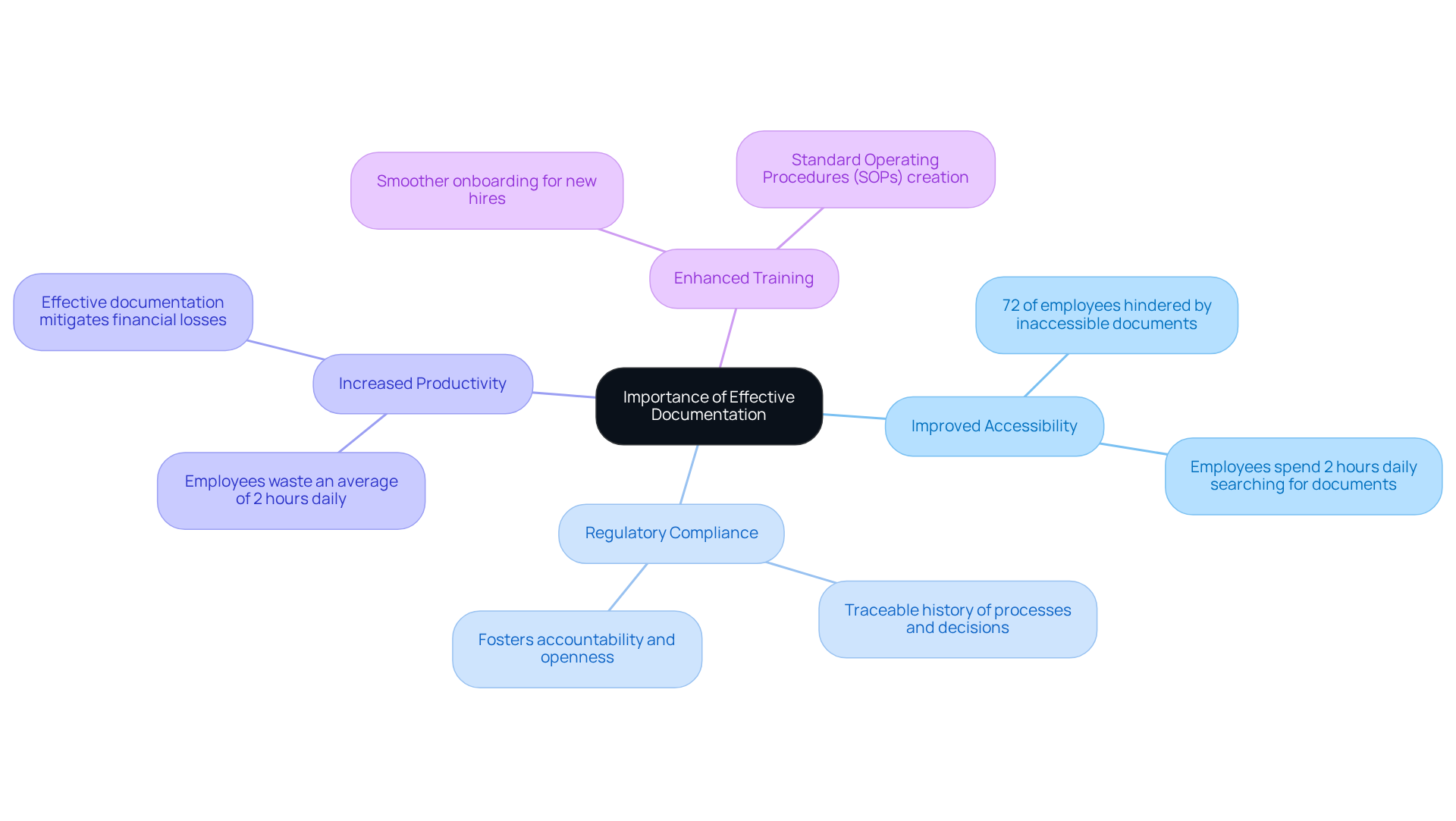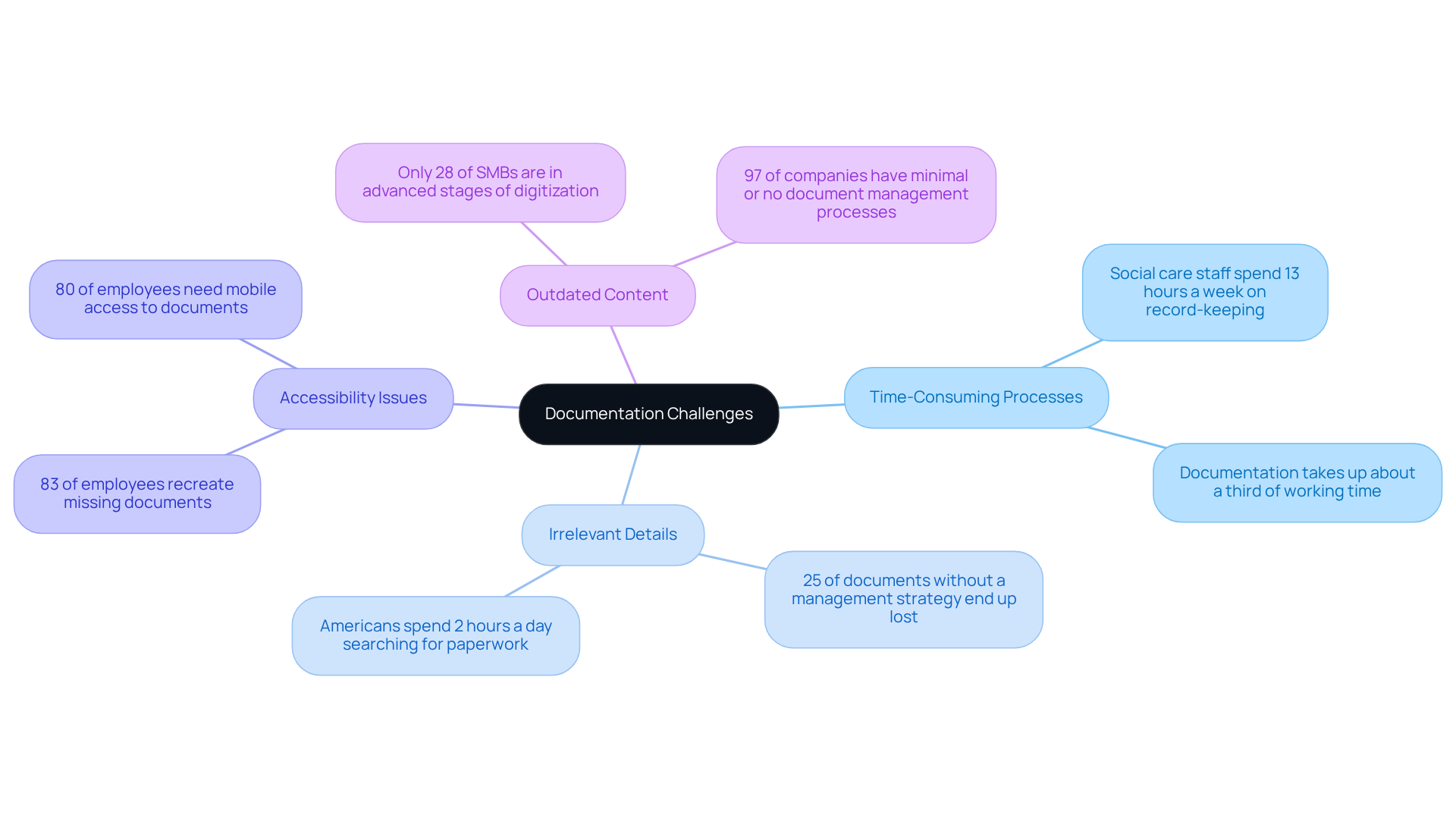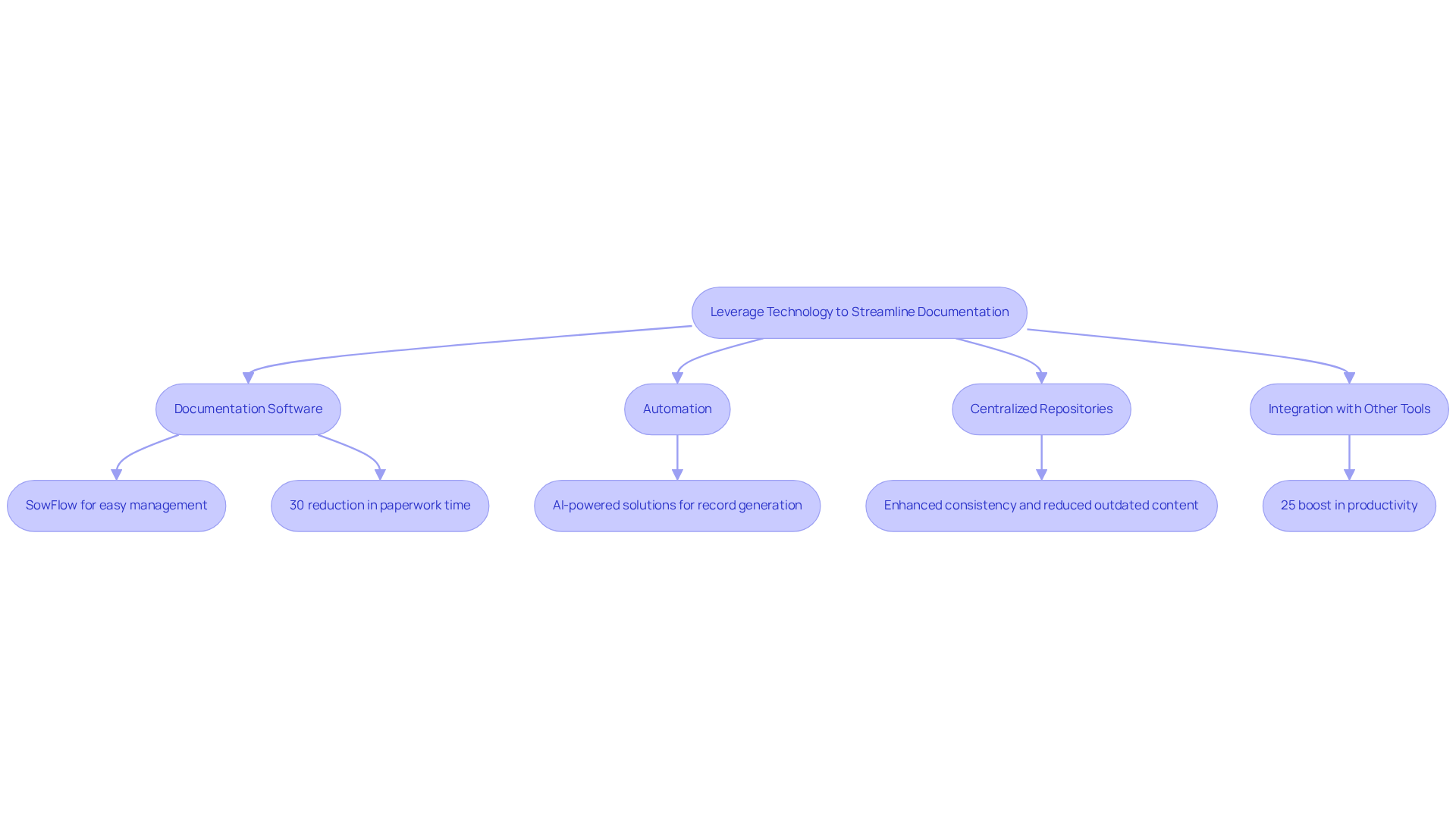
Overview
You might be wondering how effective documentation can truly make a difference in your organization. Well, this article lays out a friendly, step-by-step tutorial that highlights just how important it is for enhancing clarity, compliance, and productivity.
Think of well-organized documentation as your trusty sidekick—it not only helps you avoid time wastage and accessibility headaches but also makes the most of technology like SowFlow to streamline your document creation and management. This way, you can boost your overall operational efficiency and keep things running smoothly.
So, let’s dive into the nitty-gritty of how to get started!
Key Highlights:
- Effective documentation serves as a roadmap for processes, enhancing clarity and consistency across organisations.
- 72% of employees believe inaccessible documents hinder job performance, emphasising the need for streamlined access to information.
- Well-organised records help comply with industry regulations and reduce time wasted searching for documents, which averages two hours daily per employee.
- SowFlow is a tool that simplifies the creation of Standard Operating Procedures (SOPs) and training materials, improving efficiency and productivity.
- Common documentation challenges include time-consuming processes, irrelevant details, accessibility issues, and outdated content.
- A structured process for creating guides involves recognising procedures, gathering information, outlining, drafting, assessing, publishing, and regularly updating documentation.
- Leveraging technology, such as documentation software and automation tools, can significantly reduce paperwork time and enhance the quality of record-keeping.
Introduction
You might be wondering how effective documentation can really make a difference in your organization. Well, think of it as the backbone of operational success—a vital roadmap that helps teams navigate through complex processes. By embracing structured documentation practices, you can unlock some serious benefits, from better training for new hires to improved compliance with industry regulations.
But let’s be real: many teams face challenges like time-consuming record-keeping and accessibility issues. So, how can your organization streamline documentation efforts to boost efficiency and productivity? Now, let’s dive into that!
Understand the Importance of Effective Documentation
You know, effective documentation really is a game changer for any organization. It’s like having a that serves as a clear roadmap for all your processes and procedures. When everyone’s on the same page, accessing vital information becomes a breeze. By using a step-by-step tutorial to document workflows systematically, you can , make training new hires smoother, and keep things consistent across the board. Did you know that 72% of employees think that inaccessible documents really mess with their job performance? That just shows how important it is to .
Speaking of clarity, are a huge help in sticking to industry regulations. They provide a and decisions, which is super important. This clarity doesn’t just —employees waste an average of two hours each day hunting for documents! It also fosters a culture of accountability and openness within teams. There are real-world examples out there showing that organizations with solid record-keeping strategies can actually cut financial losses and . This leads to a more engaged and efficient workforce.
Now, let’s talk about SowFlow. It’s been a total game changer for teams looking to create (SOPs) and training materials without the hassle of taking separate screenshots or leaving the browser. This tool acts as a step-by-step tutorial that directly addresses those inefficiencies we just talked about, simplifying paperwork and saving precious time. One user even said, "SowFlow returned a portion of my life," which really highlights how this tool can streamline record-keeping and boost productivity. By incorporating methods like using SowFlow's resource tool to simplify processes, companies can reach new heights of efficiency and success, enhancing operations and team dynamics.

Identify Common Documentation Challenges in Operations Management
You might be wondering why organizations struggle so much with . Well, it often boils down to a few major challenges, especially when it comes to time, team involvement, and the significance of information. Let’s take a closer look at some key issues:
- : Many employees find documentation to be a bit of a drag, which can lead to incomplete or rushed entries. Did you know that social care staff spend around 13 hours a week on record-keeping? That’s about a third of their working time, which definitely pulls them away from their main responsibilities.
- Irrelevant Details: It’s all too easy for documentation to get bogged down with unnecessary information, making it tough to find the essential data you really need. This can waste valuable time, with reports showing that 25% of documents without a management strategy end up lost. On average, Americans spend two hours a day just searching for the right paperwork!
- : If records aren’t centralized or easy to access, employees can find it frustrating to locate critical information. A lack of effective means that 83% of employees often have to recreate missing documents. Plus, with 80% of employees needing to access documents from their mobile devices, it just adds to the inefficiencies.
- : Without regular updates, materials can quickly become outdated, leading to confusion and mistakes. Shockingly, only 28% of small and medium-sized business employers are in advanced stages of digitization, and 97% have minimal or no document management processes. This really highlights the need for better .
By recognizing these challenges, organizations can begin a to implement strategies that simplify their record-keeping efforts. This could lead to improved efficiency and productivity across teams. So, what are you waiting for? Let’s dive into some solutions!

Follow a Structured Process for Creating Comprehensive Guides
Creating comprehensive guides can feel like a daunting task, but it doesn't have to be! Let’s break it down into a that makes it easier for everyone involved:
- Recognize the Procedure: First things first, figure out which procedures need records and rank them by how important they are to your operations. Did you know that ? That’s a pretty compelling reason to keep !
- Gather Information: Now, it’s time to team up with subject matter experts. Collect all the necessary details about the process—this includes steps, roles, and resources. Getting everyone involved not only enriches the information but also builds a culture of collaboration, which is key for .
- Outline the Guide: Next, create a clear outline that organizes everything logically. This makes it super easy for users to follow. Think of the outline as your roadmap for the —it helps keep you on track!
- Draft the Documentation: When you start writing, use clear and concise language. The step-by-step tutorial should ensure that each step is actionable and easy to grasp. Remember, effective record-keeping strategies can really boost productivity and help avoid financial pitfalls.
- Assess and Modify: Bring your team together to review the records. This is your chance to spot any mistakes and gather feedback for improvements. A collaborative approach not only enhances accuracy but also builds support from the team.
- Publish and Distribute: Once everything looks good, make sure your materials are easily accessible to all relevant team members. Everyone should know where to find the information they need. A can really streamline access and cut down on time spent searching.
- Regular Updates: Finally, set up a schedule for reviewing and refreshing your records. . Organizations that stay on top of their records can adapt more quickly to changes in the business landscape, which boosts overall efficiency.
So, what do you think? Ready to tackle your documentation challenges with this structured approach?

Leverage Technology to Streamline Documentation Efforts
Technology plays a crucial role in simplifying record-keeping efforts, and you might be wondering how to leverage it effectively. Let’s dive into some friendly tips that can really make a difference:
- : Have you tried using tools like ? They offer a super user-friendly interface for creating and managing documentation. With features like templates, version control, and collaboration capabilities, it’s a breeze! Plus, did you know that organizations adopting can cut down their paperwork time by up to 30%? Pretty impressive, right?
- Automation: Imagine ! A on implementing automation tools can seriously simplify your record-keeping process. For example, can generate records based on your actions, saving you tons of time on manual updates. Who wouldn’t want that?
- Centralized Repositories: What if all your records were stored in one easy-to-access place? A allows your team to update information effortlessly, enhancing consistency and reducing the chances of outdated content. There’s a great case study titled '' that shows how SowFlow helped organizations keep their records fresh and relevant, making onboarding smoother and boosting operational efficiency.
- Integration with Other Tools: Now, let’s talk about making your life easier. Ensure your writing tools connect seamlessly with other software your company uses, like project management or communication platforms. This can really enhance collaboration and efficiency. Industry experts say that effective integration can lead to a 25% boost in team productivity—who wouldn’t want that?
By embracing technology, organizations can create a step-by-step tutorial that reduces documentation time while also enhancing the overall quality and accessibility of their guides. So, what are you waiting for? Let’s get started on making record-keeping a breeze!

Conclusion
You know, effective documentation really is a cornerstone for any organization that wants to boost operational efficiency and build a culture of accountability. By using structured approaches and some handy tools, organizations can simplify their record-keeping processes. This way, everyone on the team can easily access crucial information right when they need it. It’s a great way to cut down on misunderstandings and training time for new hires, and it can seriously ramp up overall productivity.
Now, let’s talk about some common challenges that pop up in documentation management. We’ve all been there—time-consuming processes, irrelevant details, accessibility issues, and outdated content can really get in the way. But don’t worry! By following a systematic approach to create comprehensive guides and tapping into technology like SowFlow, organizations can tackle these hurdles head-on. The insights we’ve shared here really emphasize the value of collaboration, regular updates, and integrating documentation tools to create a smoother workflow.
So, in wrapping this up, let’s not underestimate the importance of effective documentation. Organizations that make it a priority to keep their records clear, accessible, and up-to-date will not only improve their operational efficiency but also empower their teams to shine. It’s time to embrace these strategies and tools, transforming documentation from a daunting task into a streamlined process that fuels success and engagement all around.
Frequently Asked Questions
Why is effective documentation important for organizations?
Effective documentation serves as a clear roadmap for processes and procedures, helping to ensure everyone is on the same page. It reduces misunderstandings, facilitates smoother training for new hires, and maintains consistency across the organization.
How does inaccessible documentation affect employees?
Inaccessible documents can significantly hinder job performance, with 72% of employees believing that such issues negatively impact their work.
What are the benefits of well-organized records?
Well-organized records help adhere to industry regulations by providing a traceable history of processes and decisions. They also enhance productivity, as employees typically waste an average of two hours each day searching for documents.
What impact does effective documentation have on workplace culture?
Effective documentation fosters a culture of accountability and openness within teams, leading to improved engagement and efficiency among employees.
How can organizations improve their documentation processes?
Organizations can improve documentation processes by utilizing tools like SowFlow, which simplifies the creation of Standard Operating Procedures (SOPs) and training materials without the need for separate screenshots or navigating away from the browser.
What is SowFlow and how does it benefit teams?
SowFlow is a tool designed to streamline the creation of documentation and training materials, addressing inefficiencies in record-keeping. Users have reported significant time savings and enhanced productivity, with one user stating that 'SowFlow returned a portion of my life.'
How can effective documentation lead to financial benefits for organizations?
Organizations with strong record-keeping strategies can reduce financial losses and enhance overall performance, contributing to a more engaged and efficient workforce.
👍
What others are liking
5 Steps to outline your ideal documentation structure
5 MINS READ
Where to start the your journey of mapping out your ideal documentation structure, aligning it with the very heartbeat of your organization?
Defining a winning level of detail in your process
3 MINS READ
What is too much detail, and what is too little? This article described in that winning level detail about what detail is enough.





